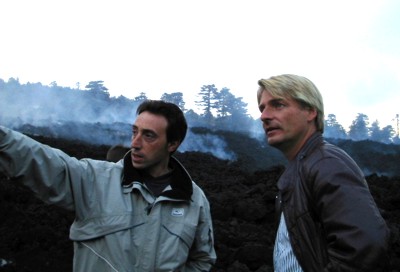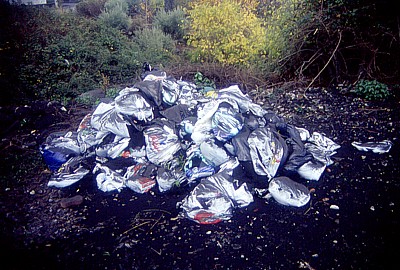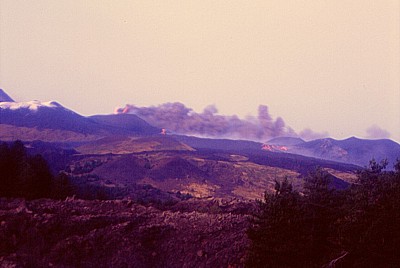 |
Measuring Etna's sliding flank, 20 November 2002
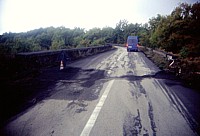 |
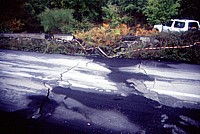 |
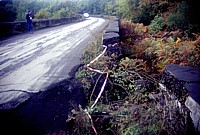 |
Following
the spectacular ground deformation and meter-scale displacements
along the Pernicana Fault (which actually is a system of faults,
extending over a distance of nearly 20 km from the Northeast Rift
to the Ionian coast and probably continues offshore), movement
of Etna's unstable eastern flank has slowed but never ceased,
and routine measurements along the known fault zones bounding
and traversing the mobile sector are carried out. The faults and
their activity are most evident on paved roads, walls and buildings,
and the Pernicana Fault is the most impressive of them. These
photographs show the northermost of three sets of fissures cutting
the Fornazzo-Linguaglossa road near the village of Vena, on the
east-northeastern side of the volcano, where displacement amounted
to more than 0.3 m during the 25 days since the beginning of the
eruption. Note the horizontal displacement of the median strip
well visible in left photograph and displacement of lateral wall
(which has partially broken down as a result of the vigorous movement)
in right photograph, and the ubiquitous black ash of the ongoing
eruption |
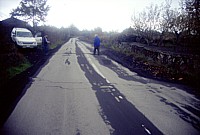 |
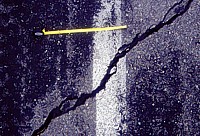 |
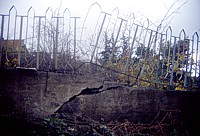 |
The
southernmost of three zones of severe ground rupturing where the
Pernicana Fault crosses the Fornazzo-Linguaglossa road is seen
in left photograph. This zone is marked by a graben (a zone of
subsidence between two more or less parallel sets of faults),
with the persons standing on the northern rim of the graben. Further
subsidence occurred during the following months (and continues
as of August 2003), reaching vertical amounts of up to 0.1 m.
The center photograph shows one of about a dozen cracks displacing
the road's median strip in the central zone of ground rupturing.
Further downslope, at the village of Presa, the Pernicana Fault
zone undergoes a transition and bifurcates in several subparallel
faults, which are connected by north-south trending thrust faults.
The action of a thrust fault is pretty well illustrated by the
fence and concrete wall delimiting an abandoned terrain at Presa:
the left (western) portion of the wall is pushed (thrust) over
the one to the right (east) |
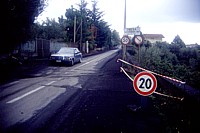 |
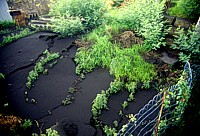 |
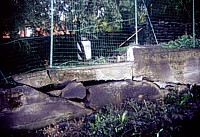 |
The
village of Presa (which, translated literally, means "grip")
in the grip of the Pernicana Fault: the road leading from the
village to the south is severely fractured by one of the segments
of the fault, and the lateral wal has been broken down (left image);
peculiar fracture pattern affecting the pavement of a terrace
in an abandoned garden, with plants growing through the cracks
(center); another wall affected by thrust faulting (right) |
Ashes
to ashes, 20 November 2002
|
For
more than three weeks, ash has been falling around Etna, mostly
in its eastern and southern sectors. It is everywhere, on the
roads, on the roofs, in the gardens, in your home. Some local
authorities invited the population to collect the ash in plastic
bags and leave these in specially designed places within and near
to the population centers in the area. Numerous plastic bags filled
with Etna's ash were brought to these places, but no one ever
thought of removing them from there. Sights like this are quite
common (the photo was taken at the village of Presa, on the northeastern
flank of the volcano, on 20 November 2002) during the eruption.
As of August 2003, nothing much has changed, except that nearly
all of the plastic bags have been torn to shreds by various processes
and released their contents onto the surrounding terrains, in
a peculiar process of recycling enhanced by mankind |
Erratic
eruptive activity, 23 November 2002
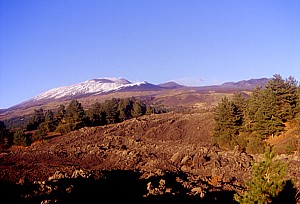 |
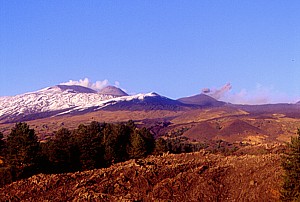 |
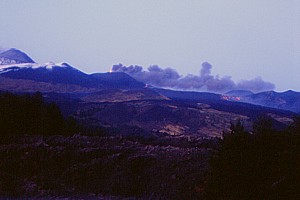 |
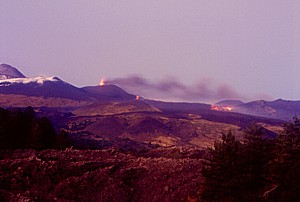 |
Observations
made on 23 November from the gate at the entrance to the Etna
Natural Park at the "Milia" (southwestern flank of Etna)
reveal that the eruptive activity from the growing cone on the
upper southern flank of the volcano is characterized by long pauses,
lasting up to 30 minutes. The photographs in the top row show
the snow-covered summit craters (the cone of the Southeast Crater
is well visible in the right photograph), and in front of them
and the new cone, the prehistoric cone of Monte Frumento Supino,
also covered with a light dusting of snow. In the first image,
the new cone is nearly completely inactive, while a few small
ash puffs are emitted in the second image. The bottom row photographs,
taken at nightfall, show the resumption of activity, which occurred
in a peculiar manner. A narrow, pulsating jet of incandescent
material mixed with ash began to rise from a vent at the summit
of the active cone, bearing a striking resemblance with an oil
fire, and continue in this manner for about 20 minutes. This was
followed by Strombolian bursts and a clear increase in the vigor
of the explosive activity. Incandescent spot at right base of
erupting cone marks the site of the active effusive vent, and
an active lava front is visible further to the right, just in
front of the pyroclastic cone formed in 2001 |
|
Lava
jetting in small fountains from two vents at the summit of the
growing pyroclastic cone on the evening of 23 November 2002. The
ash plume generated by this activity is driven to the southeast
by a very strong wind. Other features visible in this photograph
are the southern flank of the Southeast Crater cone (at extreme
left), the snow-covered Monte Frumento Supino (left), the 2001
pyroclastic cone (Monte Josémaria Escrivà, behind
the active lava front at center right), and the Montagnola (right) |
Last
impressions of an eruption, December 2002
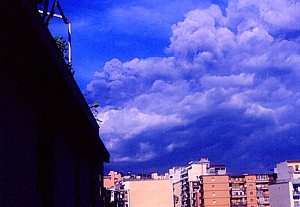 |
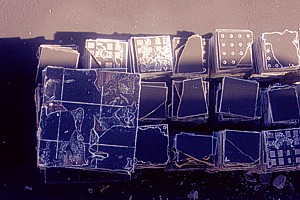 |
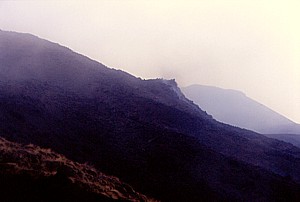 |
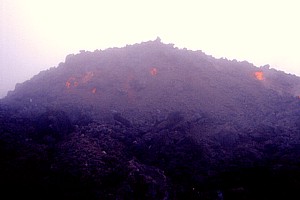 |
These
are some of the last photos I took of the 2002-2003 eruption,
much more than one month before it eventually ended. Like most
people living near and/or working on the volcano, I had become
tired of the eruption and waited only for it to end. During the
last month of activity, I hardly looked at the volcano and its
perpetual ash plume. I had not been in Catania when the eruption
began, and I was not there when it ended, although the reason
for my absence was the loss of a dear family member in Germany.
The photos show (top left) a dense ash cloud drifting eastward
one morning in early December 2002, as seen from my home in Catania;
(top right) interesting patterns created by the volcanic ash deposited
on ceramic tiles that had been removed (and partially broken)
from the walls of a room in the apartment below my one and left
on a balcony, where the ash fell on them; (bottom left) peculiar
doming of a slowly advancing, small lava front near the Rifugio
Sapienza, mid December 2002, with one of the cones of the Monti
Calcarazzi (formed in 1766) in the background; (bottom right)
advancing lava front near the Rifugio Sapienza in the fog, mid
December 2002 |
Continue
with the photos of 2003
Return
to the Etna photo gallery
|
![]()

